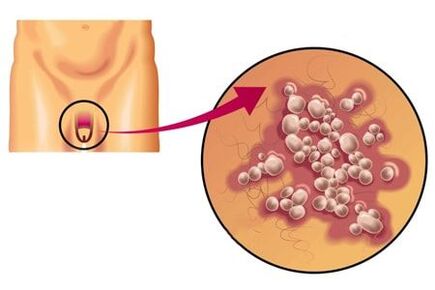Discharge from the genital organs can bother not only girls, but also men. Males have normal, odorless discharge. Its source is the urethra. In women, the discharge is called leucorrhoea. If you notice unhealthy discharge, immediately make an in-person appointment with a urologist.
Normal or pathological?
The urethra is the male urethra. From there they appear from time to time. There is something called urethrorrhea. It can be physiological or libidinal. A transparent discharge appears from the exit of the urethra. This happens in the morning, immediately upon waking up, or when a man is sexually aroused.
Urethrorrhea can be more or less pronounced. The lubricant that is released during arousal contains sperm. Therefore, if you do not want to have children yet, you should protect yourself even during foreplay with the genitals. The discharge in men helps sperm pass through the urethra and into and through the partner's vagina. After all, the environment there is acidic and this is harmful to the life of sperm.
pathological discharge
The physiological discharge that normally occurs in boys and men is described above. Here we will look at discharge associated with health problems. Mainly pathological discharge from the urethra worries menfor urethritis. This is an inflammatory process that develops in the urethra. Urethritis can be caused by infection or non-infectious factors.
The infection can be specific or nonspecific. Specific is mainly trichomoniasis or gonorrhea. TOnonspecific urethritisIt can be caused by the following pathogens:
- mycoplasma
- ureaplasma
- chlamydia
- herpes
- staphylococcus
- streptococcus
Non-infectious causes of urethritis.and associated discharge from the genital tract:
- trauma, narrowing of the urethra
- irritation due to chemical factors
- Mechanical damage to the mucous membrane.
- influence of allergens
Discharge from the genital tract in men can vary in color and transparency. It depends on how active the inflammation is, what stage it is in, and what flora is causing it.Penile discharge includes::
- silt
- liquid
- cells of various origins
If there is a lot of the last mentioned component, the secretion becomes cloudy, which the man himself can observe visually. If large numbers of epithelial cells appear in the secretion, the secretion thickens and acquires a gray tint.
if you find yourselfgreenish-yellow, greenish, or yellowish dischargeMost likely, they contain many leukocytes. This means that the secretion contains purulent masses, which are a consequence of the inflammatory process. With the same disease, the discharge can be of different thickness, quantity and nature. For example, at the beginning of the disease they may be thicker and then gradually become more and more liquid. This is such an individual process that during an examination the doctor will not be able to determine your illness and you will have to undergo a series of tests.
Discharge in menwhiteIt can have different reasons. The first thing doctors assume is the proliferation of the Candida fungus. The disease is called accordingly -. You've probably heard that women get thrush. It also occurs in men, but usually occurs hidden. But in rare cases, white discharge from the genitals may appear.
Smelly discharge
The first possible reason (and the most harmless) is lack of hygiene. As mentioned above, smegma is a normal male discharge (not an indication of disease). If you do not wash regularly, at least once a day, smegma accumulates and bacteria multiply in it, causing not very pleasant odors. These smells may differ for different men.
If you follow good hygiene rules and still have an unpleasant odor, your doctor may suspect a metabolic disorder. In such cases, the most common cause is diabetes. The smegma will be released in fairly large quantities, so your clothes will be wet.
Infections are also the cause of smelly discharge in men. The pathological process occurs mainly in the urethra. Your doctor may suspect urethritis due to a gonorrheal infection. The nature of the download is described above. If the discharge from the penis in men has a sour odor, most likely urogenital candidiasis is developing.
Bloody discharge in men.
The main reason is infections. The discharge may be completely bloody or include streaks of blood. If the infection multiplies in the urethra, you will notice that symptom, but not necessarily. Urethritis is mainly caused in these cases by candida, trichomonas or gonorrheal infection. The stronger the inflammation, the more blood is released.
The blood may be due to chronic inflammation of the urethra. The essence of the process is that the mucous layer of the urethra is loosened. If an irritant acts, the membrane is damaged and begins to release blood. Even urinating can be irritating.
Probable reason number two is medical procedures performed carelessly. The urethra is injured, so blood is released. Procedures that can cause damage to the urethra:
- catheter installation
- catheter removal
- bougienage
- taking a stain
- cystoscopy
Bloody discharge is immediate. It should be noted that in this case the blood is scarlet, without clots and stops quickly.
The passage of stones and sand is the next cause of bloody discharge from the penis. They are secreted by the kidneys or bladder and pass through the urethra. Microliths are hard, damaging the mucous membrane and walls of blood vessels, which becomes the direct cause of bleeding. Pain also occurs.
Discharge of blood with sperm.
This discharge is called "hematospermia. "It can be true and false. If hematospermia is false, then the blood mixes with the sperm as it passes through the urethra. If this pathology is true, then the blood mixes with the sperm before passing through the urethra.
Hematospermia manifests itself with the following symptoms:(clinical picture):
- urinary disorders
- pain during ejaculation
- discomfort and pain in the lower back
- pain and/or swelling in the genitals
- high body temperature
Causes of blood discharge with semen.:
- long-term sexual abstinence
- too active sex life (during intercourse, the walls of blood vessels break)
- varicose veins of the pelvic organs
- stones in the testicles and vas deferens
- malignant and benign formations in the genitourinary organs
- biopsy
- genital surgery
If you notice discharge from your genitals that does not go away within a day or two, immediately seek an in-person consultation with an experienced doctor. If discharge appears after unprotected sexual intercourse, it is not necessary to sound the alarm, but go to the doctor and get tested as soon as possible. Cheers to you and your other halves!
Discharge from the genital organs in men is discharge from the urethra (urethra) and discharge.preputialGlands found on the head of the penis, under the skin of the foreskin. The urethra opens.ejaculatorduct, prostatic ducts,urethralANDbulbourethraliron
Variants of physiological secretions.
Criteria for normal discharge.corresponding to the functions of the organs of the urogenital system:
- Urine- transparent, straw yellow to golden in color, practically odorless, without scales or other inclusions;
- prostate secrethas a viscous consistency and a whitish tint, there is a specific smell of sperm;
- Ejaculate:The sperm from the ejaculatory duct mix with the secretions of the Littre (urethral), Cooper (bulbourethral) glands and prostatic secretions, acquiring a grayish white color and a mucous consistency;
- fresh smegmafrom the preputial glands it appears a thick white lubricant; It may turn yellowish or greenish over time.
Preputial lubrication –smegma– constantly stands out, accumulating under the inner layer of the foreskin and in the coronary sulcus of the penis. The lubricant is composed of fats and bacterial residues, is distributed evenly and reduces friction between the skin of the foreskin and the glans. The maximum activity of the preputial glands is characteristic of the period of puberty, with age the secretion decreases, and with old age it stops completely.
Urethrorrhea, colorless mucous discharge.of the bulbourethral and urethral glands. They appear only with the excitement associated with libido. The excretion of clear mucus aims to lubricate the urethra and improve the passage of sperm. The amount of secretion varies from scant to abundant, these parameters are related to the individual characteristics of the body and the frequency of sexual activity. After prolonged abstinence, the volume of secretion increases.
Emission: spontaneous release of sperm., not associated with sexual relations. It is usually seen in the morning, when testosterone levels increase. It depends on the age and intensity of sexual activity: it appears in children during puberty, in adult men, with irregular or infrequent sexual relations.
Prostatorrhea, discharge of a small amount of clear mucus from the urethra.with grayish white inclusions. It occurs after straining the abdominal muscles (for example, with constipation) or after urinating. The secretion consists of a mixture of seminal fluid and prostate secretion; Increased volume and cloudiness can be signs of prostatitis.
pathological discharge
In men, the causes of penile discharge can be sexually transmitted diseases, tumors, nonspecific inflammation of the urogenital organs, various injuries, medical procedures or operations.
Pathological discharge from the urethra differs from normal:
- By volume (too abundant or scarce, perhaps moderate);
- By color and transparency (from white to greenish-yellow, cloudy);
- Due to impurities (blood, pus, lumps of mucus);
- Consistency (too runny or too thick and sticky);
- By smell (acid, putrid, fishy);
- Depending on the frequency of appearance (depending on the time of day, constant or episodic secretion);
- In relation to urination, sexual arousal, alcohol consumption, spicy and spicy foods.
The nature of the secretion depends on the causative agent of the disease, the state of the immune system and concomitant ailments., as well as the severity and duration of the inflammation (acute or chronic).
If there is a change in the amount, density or color of the discharge, or if an unpleasant odor appears, it is recommended to consult a doctor and undergo tests. There is no point in self-diagnosing, it is very difficult to correctly recognize the disease based on a single symptom.
Penile discharge associated with STDs

Mucous: transparent, viscous secretion and in small quantity, occurs in chronic form or urethritis. Microscopy reveals a moderate number of leukocytes in the secretion (the norm is up to 4 cells in the field of view).
mucopurulent: white, translucent discharge; observed in the acute phase of chlamydia, ureaplasmosis and mycoplasmosis. In chlamydia infection, they accumulate on the head of the penis, as if they "stick" to the skin.

purulent discharge, which have an unpleasant odor, are characteristic of. They are sticky, thick, yellow or greenish in color and have a putrid odor. Under the microscope, epithelial cells from the urethra and many leukocytes can be seen in the material.
Symptoms accompanying gonorrheal urethritis: abundant and constant discharge; especially strong when urinating.
In sexually transmitted diseases, combined infections are often observed, combining several pathogens at once. Gonorrhea and are accompanied by chlamydia, mycoplasmosis and ureaplasmosis usually occur "in pairs. "The symptoms of these diseases differ from the classic manifestations; Urethral discharge can also take on a completely different character. Therefore, modern analytical techniques with a high degree of reliability are used for the final diagnosis, and not the characteristics of the secretions.
Nonspecific (non-venereal) inflammation
The cause of nonspecific inflammation is the patient's own microflora, which is classified as opportunistic and is activated only in case of problems with the body's immune defenses. Streptococcus and staphylococcus, fungi of the genus.candidand E. coli are always present on the surface of the skin and mucous membranes, but begin to actively multiply and displace beneficial bacteria after hypothermia, prolonged stress, uncontrolled treatment with antibiotics, after courses of radiation and chemotherapy.
Discharge not associated with inflammation.

Spermatorea: secretion in the form of passively flowing spermatozoa,They occur outside of sexual intercourse or masturbation, without the sensation of orgasm. The reasons are some diseases of the nervous system, spinal injuries, chronic stress and any prolonged inflammation of the genital area. Spermatorrhea is associated with altered innervation and decreased tone of the vas deferens.
hematorrhoea,bloody problems. It often appears with urethral canal injuries received duringbougienage, after productioncatheteror when taking a smear from the mucous membrane. In these cases, the blood is fresh, without clots, the amount is small, and the bleeding stops quickly. When small kidney stones or sand pass, blood is released during or immediately after urination, hematorrhoea is accompanied by very severe pain (renal colic). Discharge of blood duringhematuric form of glomerulonephritis(inflammation of the renal glomeruli) are combined with edema and persistent high blood pressure, the appearance of protein in the urine.
The discharge is brown, with blood clots or mucus, mixed with pus, appear with malignant tumors emanating from the prostate, urethra or bladder. During wound healing, brownish mucus may form on the mucous membranes and is released during polyposis of the urethra and/or bladder.
Prostatorrhea- prostate secretion flowing from the urethra. It occurs in chronic prostatitis, prostate adenoma, altered innervation (neurogenic bladder).
Examination algorithm for the presence of pathological discharge from the penis.

- Inspection of the perineum, penis, foreskin and glans.The goal is to identify deformations of the genital organs, traces of injury, signs of external inflammation, discharge, rash, etc. Sometimes traces of discharge are noticeable on underwear.
- Palpation of the inguinal lymph nodes, assessment of their condition:size, whether they are warmer or colder than the surrounding tissues, painful or not, soft or dense, mobile or fused to the skin, whether they have ulcerations on them.
- Digital prostate examination;massage the prostate through the rectum and obtain secretions for microscopic examination. Before the massage it is advisable to refrain from urinating for 1-2 hours. With prostate adenoma, its lobes enlarge approximately equally, and dense cords are palpated. Uneven growths and their consistency are typical of a malignant tumor; during palpation of the prostate, blood with clots can be released from the urethra.
- Material – for microscopy.When examined under a microscope, the stained smear reveals blood cells, epithelium, sperm, fatty inclusions and some pathogens (Escherichia coli, gonococci, gardnerella, yeast).Increased white blood cell countCharacteristic of acute urethritis or exacerbation of chronic inflammation.eosinophils– for urethritis with allergies.red blood cellsIt is found in severe inflammation, tumors, lesions of the genitourinary organs and urolithiasis.Large amount of epithelium– a sign of chronic urethritis, urethral leukoplakia. When spermatorrhea is found in a smearspermatozoon, with urethrorhea –silt, simpler -lipid grains.
- General clinical blood test.,blood for sugar- in the morning, on an empty stomach.Detailed urine analysis(morning portion, immediately after sleeping).
- Ultrasound of the prostate, bladder and kidneys; CT and urography.
If the manifestations of genital inflammation are severe, before receiving the test results, the patient is immediately prescribed broad-spectrum antibiotics. In case of heavy bleeding, hospitalization and active measures to stop the bleeding are indicated. The suspicion of a malignant tumor can only be confirmed by the result of a biopsy; The final diagnosis is made on the basis of histological examination.
Important:
- Discharge from the penis is only a symptom that cannot be used as a guide when making a diagnosis.
- Unacceptableindependent prescription of pharmaceutical products. medications, even if the manifestations seem obvious for a particular disease.

Normal amount of mucus
The volume of pre-ejaculate depends directly on the man's degree of arousal. Maximum concentration is achieved with a strong sexual desire.The normal amount of liquid is 5 ml..
Some representatives of the stronger sex are physiologically incapable of secreting lubricant. The absence of pre-ejaculation during an erection reduces the ability to conceive.
Healthy pre-ejaculation has the following characteristics:
The pre-seed performs cleaning functions, so its consistency may change. A man may experience cloudy lubricant with repeated sexual intercourse, poor hygiene, or before ejaculation. He will be back to normal in 1 or 2 days. Otherwise, the development of a pathogenic process should be suspected.

Signs of deviation from the norm
The secretion of pathological mucus in men differs from the healthy one in color, smell and consistency. They are almost always accompanied by unpleasant sensations.
Symptoms indicating a deviation of the lubricant from the norm.:
These signs are characteristic of pathological processes that indicate the development of diseases.
Unhealthy discharge in men is divided into types:
| Guy | Description |
|---|---|
| spermatorrhea | Random leakage of sperm without reaching orgasm. The cause of the process is the decrease in muscle tone of the vas deferens. Pathology develops due to chronic inflammation. |
| Hematorrhea | Discharge of lubricant mixed with blood. It appears with lesions in the urethral mucosa. |
| Leukocytic urethrorrhea | The exudative phase of the inflammatory process, resulting from thermal, mechanical, chemical or viral damage to the urethral mucosa. |
| mucopurulent | They consist of a small amount of leukocytes, serous fluid and glandular secretions. This mucus is characterized by active formation at night. A man notices pus discharge in the morning and yellow stains can be found on his underwear. Mucopurulent discharge appears when the urethra is damaged by bacteria: trichomonas, ureamycoplasma, chlamydia. |
| Purulent | They include a large number of leukocytes, urethral epithelium, mucus and serous fluid. They have a thick consistency and an unpleasant odor. They appear in the form of drops with a yellow or greenish tint. Evidence of the development of gonococcal urethritis, which is formed against the background of chlamydia and gonorrhea. |
The volume of mucus released can be abundant or small. It can be quite difficult to notice poor lubrication. To do this, you have to press the urethra so that liquid comes out through the opening. It dries quickly, forming a film on the membrane of the head of the penis. The slimy consistency causes the urethral sponges to stick together.

Causes of pathological discharge.
Lubricant secretion that differs from the norm is in most cases due to sexually transmitted diseases, but there are other conditions.
Sexually transmitted diseases
If pathological discharge appears with unpleasant symptoms, the development of sexually transmitted diseases (STDs) should be suspected. Such diseases develop under the influence of unfavorable microflora, which settles on the mucous membrane of the urethra, external areas and cavities of the genital organs and in the glands.
What changes indicate the disease?
Several changes in pre-ejaculation indicators are of concern. The reasons to immediately visit a specialist are:
- Change in the color of the liquid: it can be grayish, with a green or yellow tint (indicating the presence of purulent contents).
- Blood impurities.
- Cloudiness.
- Cottage cheese-like consistency.
- Unpleasant musty smell.
These signs indicate an inflammatory process. The following symptoms often appear:
- Pain in the lower abdomen.
- Frequent need to go to the bathroom.
- Heat.
- Hyperemia of skin areas.
- The appearance of purulent discharge from the urethra at rest (in the absence of sexual arousal).
Mucus can be released from the urethra with the development of postoperative complications during surgical operations on the prostate and other organs of the genitourinary system.
The release of clear fluid in the absence of an erection is one of the symptoms of pathology, the causative agents of which are streptococcus, staphylococcus and E. coli. A similar situation is observed when infected with sexually transmitted infections. In such cases keep in mind:
- Hyperemia of the external reproductive organs.
- Itchy sensation in the penis and scrotum.
- Swelling of the lower extremities.
If a man notices cheesy inclusions in pre-ejaculate, he should urgently consult a qualified doctor, as this indicates the presence of candidiasis. This inflammatory disease is caused by fungi of the genus Candida, which are an opportunistic microflora. Under normal conditions, they exist in the body without causing any harm. The action of negative external factors and weakened immunity contribute to the rapid proliferation of fungi and their transition to a pathogenic form.
Some sperm are found in pre-ejaculation, which makes conception possible. Therefore, if a couple is not planning a pregnancy, they should take birth control pills or otherwise protect themselves not only during sexual intercourse, but also during foreplay.
Other reasons
The prostate plays a key role in sperm formation. It produces a secretion, without which the seminal fluid loses its functionality. When the prostate becomes inflamed, its production increases.
Men who suffer from chronic prostatitis may notice that when they become aroused, a large amount of lubricant comes out of the urethral opening. It is a prostate secretion that has a fairly high similarity to pre-ejaculation.
Excessive secretion during excitement can appear with the development of various inflammatory processes.
After catheterization, the appearance of clear mucus in the urethra can be observed. This fluid is formed as a protective reaction of the body to the resulting microtrauma on the surface of the mucous membrane.
A large amount of clear discharge during ejaculation may indicate the development of infertility.
To diagnose pathologies, not only the visual nature of the liquid is taken into account, but also its biological composition. The man needs to see a doctor for examination.

























